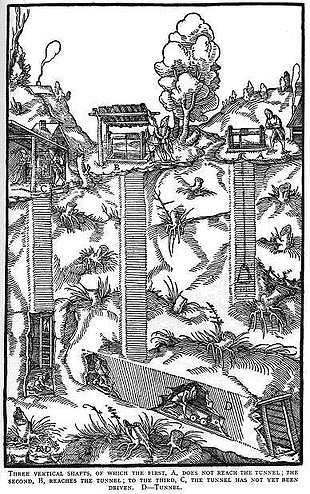Primarily for winning coal and salt (and other ores) mining was done.
 As we descend into the earth prevails the first 25 meters a constant temperature of 9 degrees. That is comfortable for underground working and living spaces and cultivating mushrooms. It provides protection against extreme heat and cold. Lower the temperature rises by 3 degrees per 100 meters.
As we descend into the earth prevails the first 25 meters a constant temperature of 9 degrees. That is comfortable for underground working and living spaces and cultivating mushrooms. It provides protection against extreme heat and cold. Lower the temperature rises by 3 degrees per 100 meters.
Shafts provide air circulation. There is a shaft with an above-ground -extending fan for air extraction and one for the intake of air, at the bottom connected by a passage. All higher-level connections have at each side a door. Of which there is only one open to regulate the proper circulation of the airflow that is always looking for the shortest path.
Shafts have a dual counter-rotating shaft wheel with which each time one elevator cage is down, while the second compensating weight is above. As a result, also less cable (or tape) must be rolled up.
Stone corridors running from the shaft are always up with an increase of 1 meter per 300 meters.
As a result, cost of material transport is lower and discharge of water into the shaft takes less energy.
The roof of the corridors was controlled by knocking. With a hollow or dull sound, there is a bad roof or hangs a clock (loose room) and that means danger.
Scots pine (Pinus sylvestris) was used as mining wood because the struts cracked, long before they started succumbing and so the miners were alerted to a collapse. Pine speaks for them breaks.
Mice also found the way down. They were sometimes enemies of the miners and their not properly hung away sandwiches. They were mostly friends, where they had enough oxygen, it was safe. The miners did not see them, but knew that they were there. They have a 7th sense. If they fled en masse then something was going to happen and the miners left the area too.
Coal-bed methane (97% methane) is lighter than air, odorless, tasteless, colorless, flammable, explosive, suffocating. CBM is at 1-4% combustible, explosive +4-14%, +14% suffocating. For the detection was earlier made use of canaries in a cage.
Checking the presence of the gases was done later with the typical shaped mine lamp, a gas lamp (by Sir Humphry Davy, 1815). She has a double brass mesh cap: gas can inside, but the flame does not go out. Mine gas is lighter than air and was measured at the ceiling. The gas forms a (blue) halo around the flame. When tested by an increased flame the mesh should not go to glow, that could ignite the gas on the outside too. Quickly retreat the lamp also was not allowed to avoid the flame to flash trough the mesh.
Carbon dioxide is heavier and was tested to the floor: it extinguishes the lamp.
By rescue crews white mice were included because burning gasoline lamp does not respond to carbon monoxide.
Also fine carbon is explosive. To avoid coal gas explosions and further in tunnels propagation in a chain reaction of explosions of carbon, planks with stone, marl and chalk dust were hung in hallways. With a blast that rock dust bolts and was overthrown by air pressure. The stone dust falls down and swirls and thereby forms an explosion inhibitory dust curtain. The flame that comes after the pressure displacement suffocated by it.
In the Dutch Heerlen is a geothermal project in which water is used in old mine shafts through a heat exchanger to heat buildings since 2005. At 700 meters, the water is 28°C hot.
